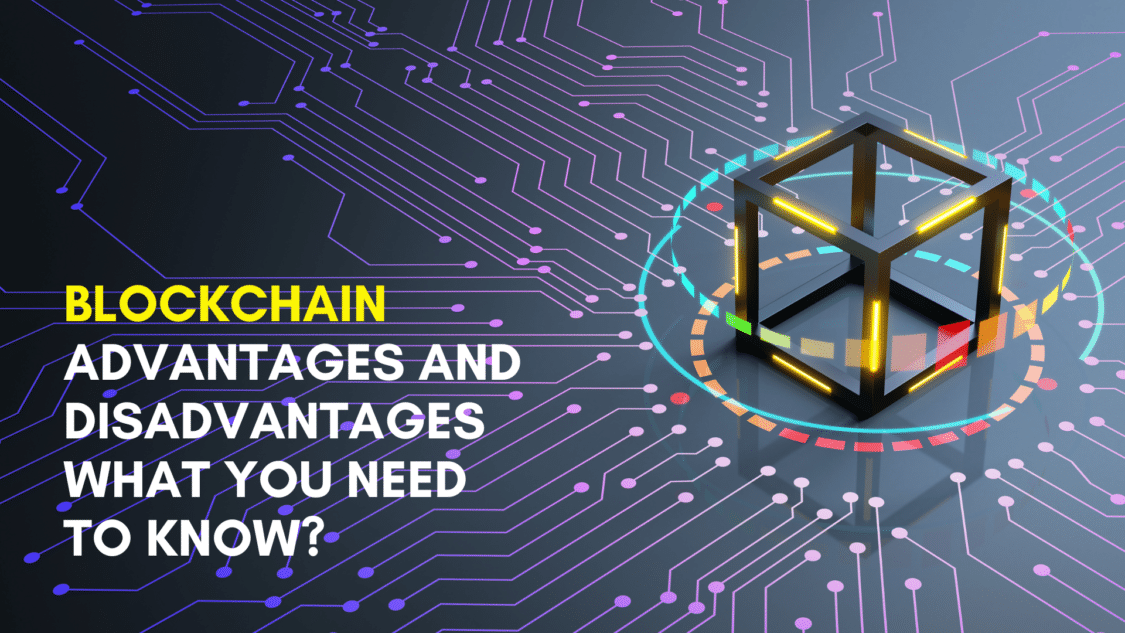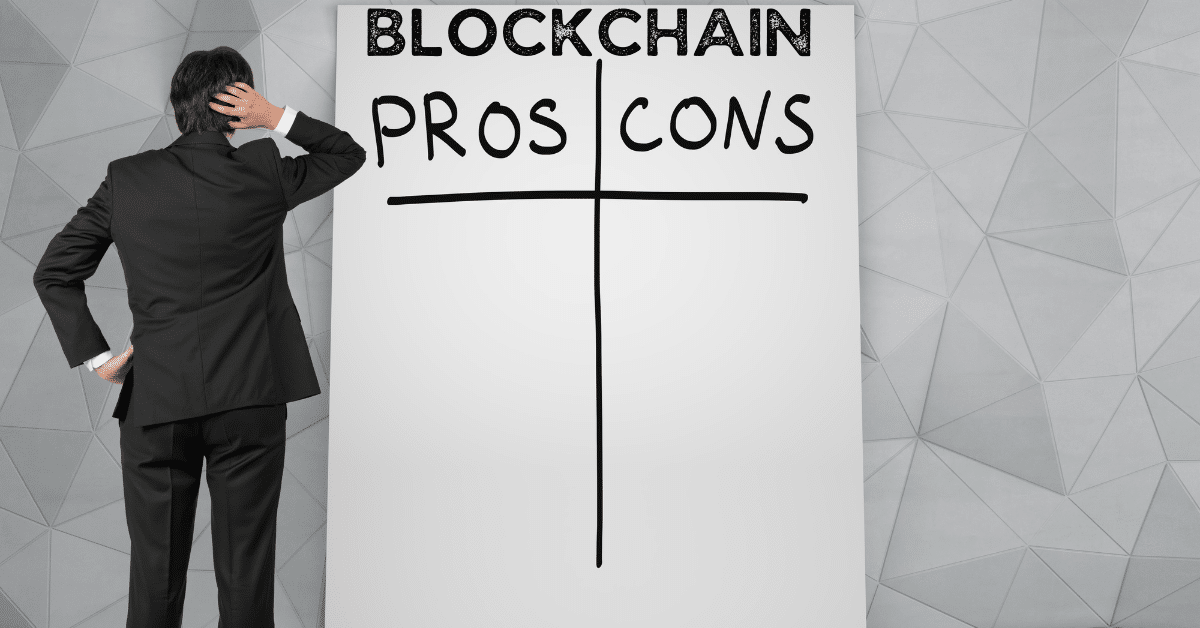There are many Blockchain Advantages and Disadvantages. A blockchain is a virtual ledger comprising data about cryptocurrency transactions. The data is stored in blocks, and this system is called a blockchain. Blockchain advantages have contributed a lot in certain industries.

What are the Advantages of Blockchain Technology?
As blockchain data is stored in many devices worldwide, the system resists attacks and technical failures. There is no chance of the network’s failure because each network node is replicated and can be stored in the database. The blockchain system is stable. Removing or modifying individual blocks once incorporated into the system is impossible. This system provides a highly effective method of financial record keeping as it captures and monitors each step and activity involved.

The blockchain system does not need an intermediary like many other traditional payment methods. The process it goes through, known as mining, is a distributed network of nodes; its job is to verify the transactions that enter the blockchain.
What are the Disadvantages of Blockchain Technology?
Now that you know the blockchain advantages, let’s go through the blockchain disadvantages.
While stability is one of the blockchain advantages, it can often be a problem. Changing blockchain data or a code on the system is challenging if needed. It requires the creation of a hard fork that abandons one chain and takes over a new one.
The blockchain network works with a private key. This key is private, and only the user has access to it. Each person is responsible for their private key. It merely serves as the password giving you access to the system and your funds. If this private key is lost, there is no way of retrieving it, meaning the money is lost.

Blockchain ledgers have the potential to grow exceedingly large over time. Currently, the Bitcoin blockchain takes around 200 GB of storage. The current pace of rise in blockchain size appears to be faster than the increase in hard drive capacity, and the network risks losing nodes if the ledger becomes too massive for individuals to download and store. As discussed above, the blockchain advantages and disadvantages are many. However, it is here to stay, and over the years, we will see where the world stands with blockchain and its value to various businesses.
What are the potential social and economic impacts of blockchain technology?
Blockchain technology has the potential to have huge social and economic consequences. It facilitates decentralisation by allowing individuals direct management over their assets and financial transactions. Enabling low-cost and efficient peer-to-peer transactions can encourage financial inclusion, particularly in disadvantaged areas.
One of the blockchain advantages is that it improves clarity and trust by enabling public verification of transactions, making it challenging to modify records. It also helps improve security and privacy by using cryptographic techniques to ensure data integrity and that individuals have control over their information. In addition, implementing blockchain technology optimises various processes and reduces associated expenses by eliminating the need for intermediaries and enabling the automation of key operations. The application of this innovation can transform multiple industries, including but not limited to finance, supply chain, healthcare, and logistics, by enhancing efficiency and traceability.
Blockchain enables disintermediation and peer-to-peer collaboration, enabling new business models and decentralised ecosystems. In addition, implementing blockchain technology optimises various processes and reduces associated expenses by eliminating the need for intermediaries and enabling the automation of key operations. The application of this innovation can transform multiple industries, including but not limited to finance, supply chain, healthcare, and logistics, by enhancing efficiency and traceability.
What are the challenges of blockchain?
Blockchain technology faces various challenges that need to be handled for broader adoption and success. The scalability issue presents a pivotal challenge in the blockchain world, given the prevalent difficulties encountered by existent blockchains in managing a substantial volume of transactions quickly and cost-effectively. It is imperative to guarantee scalability solutions that can handle high transaction throughput for the widespread implementation of blockchain technology.
Regulatory and legal considerations pose another blockchain challenge. With blockchain operating worldwide and involving various participants, compliance with different regulations becomes an issue. Creating frameworks that effectively address legal and regulatory mandates while preserving fundamental blockchain tenets, including decentralization and immutability, constitutes a crucial milestone towards this emerging technology’s extensive integration and usage.
Energy consumption is an issue, especially with proof-of-work blockchains, which require significant processing power and energy resources to mine. Discovering more energy-efficient consensus mechanisms or switching to alternative consensus algorithms can help to reduce blockchain technology’s environmental effect. The challenges of interoperability and standardization are significant. Given the numerous platforms and protocols in the blockchain ecosystem, it is imperative to attain seamless interoperability and establish shared standards to facilitate the cross-network exchange of data and assets.
The adoption of users and educational initiatives also comes with challenges. Many people do not widely understand blockchain technology and its possible applications. Implementing user-friendly interfaces, intuitive platforms, and educational resources to illustrate blockchain advantages features and employment scenarios can facilitate its adoption and empower users to utilize it efficaciously.
Managing these challenges requires ongoing research, developing innovative solutions, collaboration among industry stakeholders, and establishing governance frameworks to ensure responsible and sustainable growth of blockchain technology.
What are the key considerations when considering blockchain advantages and disadvantages in industries and sectors?
When exploring the blockchain advantages and disadvantages, key considerations can shape its performance and impact. One of the most important is scalability, which refers to a blockchain network’s ability to handle many transactions and users. While the blockchain system is known for being decentralized and transparent in transaction processing, it may face scaling issues to fulfil the increasing demands of large-scale applications. Secondly comes security which should be highly considered as well. Blockchain technology employs cryptographic algorithms and consensus procedures to provide data integrity and protection against illegal access or modification.
However, the security of blockchain networks relies strongly on the strength of encryption algorithms, critical management practices, and the overall strength of the underlying framework. Privacy is an ongoing concern with blockchain technology. While all users can see transactions on public blockchains, efforts have been initiated to improve privacy using methods such as zero-knowledge proofs and confidential transactions. Finding the right middle between transparency and privacy till today remains a challenge for blockchain technology.
Cost and efficiency are also factors to consider in the blockchain advantages and disadvantages. While blockchain can potentially streamline processes, eliminate intermediaries, and reduce transaction costs, it may also face energy consumption and transaction speed challenges, particularly in public networks with consensus mechanisms like proof-of-work.
Finally, governance and regulation are critical in shaping the adoption and implementation of blockchain technology. Balancing the need for regulation to avoid illegal activity with the need for innovation and decentralization is a constant dilemma for blockchain ecosystems.
Overall, understanding the blockchain advantages and disadvantages requires considering these significant elements, as they can substantially impact its implementation and potential impact in many businesses and sectors.
What risks and vulnerabilities are associated with blockchain, such as hacking or smart contract flaws?
One of the main concerns is the possibility of hacking and data breaches. Although blockchain is known for its security, it is still susceptible to attacks from malicious individuals who exploit network weaknesses, resulting in compromised confidential information or hindering its functionality. Automated actions on the blockchain through smart contracts may be prone to exploitation if they contain coding errors or vulnerabilities.
Errors within smart contracts may result in unexpected outcomes, monetary setbacks, or illicit alterations of transactions. One potential danger is the possibility of a 51% attack, which occurs when an individual or organization possesses more than half of the network’s computational power. This creates the potential for manipulating the blockchain’s validation of transactions and consensus mechanism.
Conclusion:
In conclusion, blockchain advantages and disadvantages shape its potential applications and adoption as a new technology. The benefits of blockchain technology, such as decentralization, transparency, security, and efficiency, can potentially change various industries, including finance, supply chain, and healthcare. Blockchain’s ability to exclude intermediaries and provide immutable records holds promise for streamlining processes and enhancing participant trust.
However, it is crucial to acknowledge the blockchain advantages and disadvantages, such as scalability issues, energy consumption, regulatory concerns, and the potential for illegal activities. While the benefits of blockchain are significant, careful consideration of its limitations and the evolving regulatory landscape is necessary for its ultimate success with blockchain technology. Overall, a blockchain advantage represents a transformative technology with significant potential, but its full potential can only be seen by addressing its blockchain disadvantages and leveraging its advantages responsibly.




